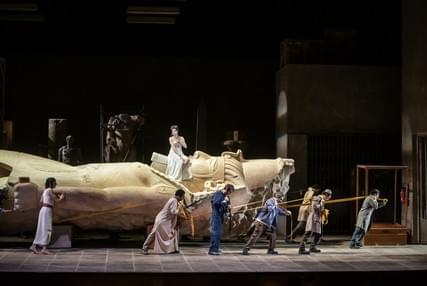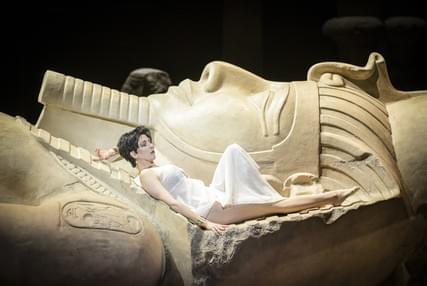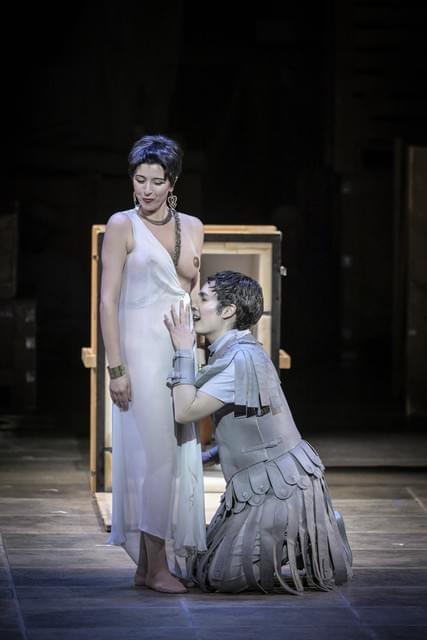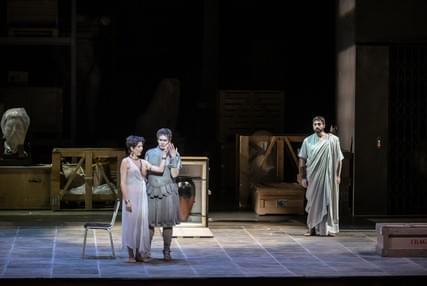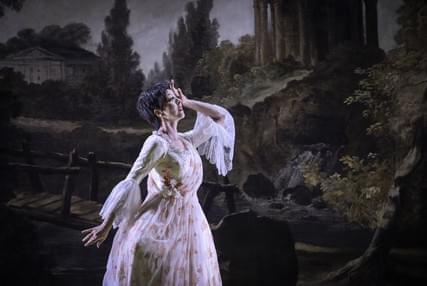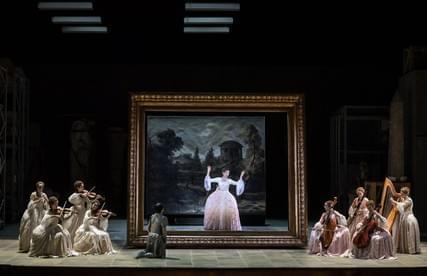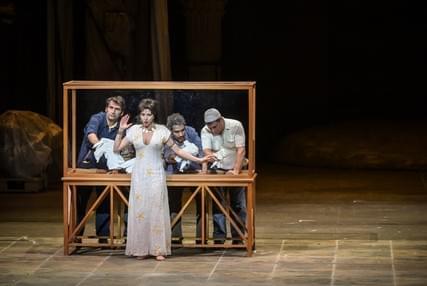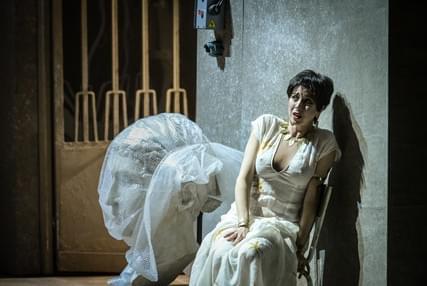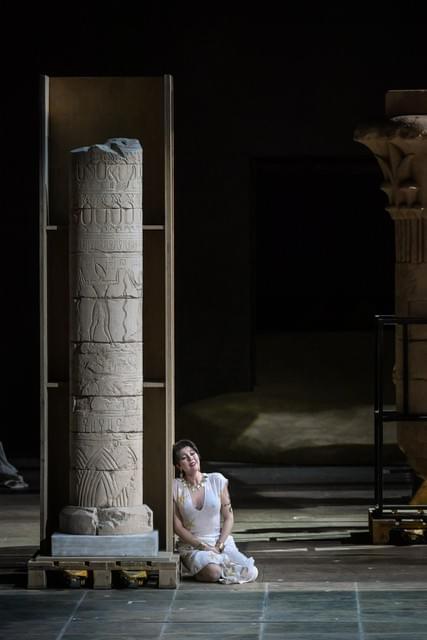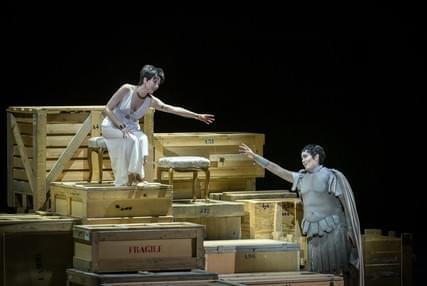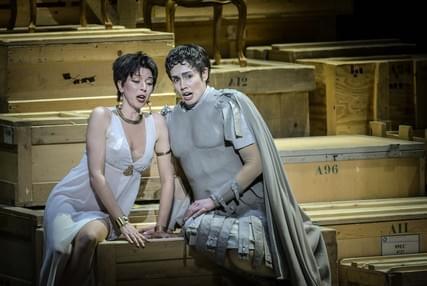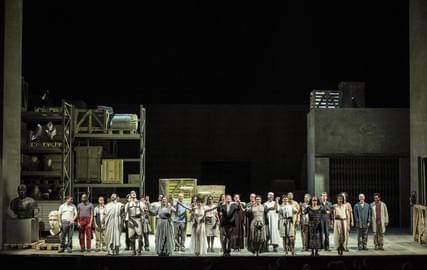Giulio Cesare
Music by
G. F. Handel

2024
January
20
19:00
January
23
19:00
January
25
19:00
January
27
19:00
January
30
19:00
February
02
19:00
February
04
14:30
February
08
19:00
February
10
19:00
February
12
19:00
February
14
19:00
February
16
19:00
Cast
| Giulio Cesare | Gaëlle Arquez | |
| Cleopatra | Lisette Oropesa | |
| Tolomeo | Iestyn Davies | |
| Cornelia | Wiebke Lehmkuhl | |
| Sesto | Emily D'Angelo | |
| Achilla | Luca Pisaroni | |
| Curio | Adrien Mathonat | |
| Nireno | Rémy Brès |
Harry Bicket
DirectorLaurent Pelly
Set DesignerChantal Thomas
LightingJoël Adam
DramaturgeAgathe Mélinand
ChorusmasterChing-Lien Wu
About
A love story between two illustrious figures of antiquity - Caesar and Cleopatra - and power struggles in Egypt: these ingredients alone could explain the immediate success of Julius Caesar at its premiere in 1724 at the Haymarket Theatre in London. But if it became Handel's most popular opera, it is above all thanks to its sumptuous orchestration and its prodigious musical invention. Each character is painted with great psychological finesse, especially Cleopatra, one of the most beautiful portraits of women in the history of music. The director Laurent Pelly places the action in the storerooms of a museum, in the department of Egyptian antiquities, creating delicious shifts between characters in togas and busy handlers. A playful way to break the codes of opera seria, which was precisely Handel's objective.

Interview - Les Grands Entretiens - France Musique
Lisette is interviewed in a 5 part series on Les Grands Entretiens on France Musique
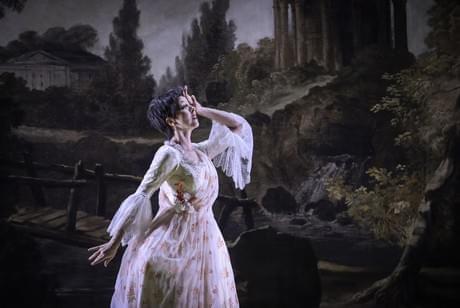
Interview - France Culture - Affaires culturelles
Lisette is interviewed by Arnaud Laporte of Affaires culturelles on France Culture Radio
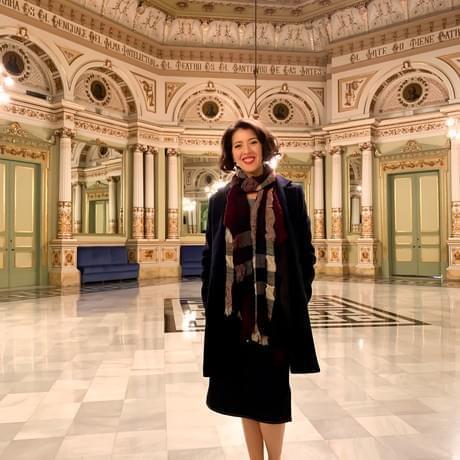
Interview - New York Times - UNESCO
Lisette is interviewed in the New York Times about Italian Opera heritage and UNESCO

Interview - Point de vue
Lisette is interviewed in Point de Vue magazine

❄️ Lisette's Winter 2024 Newsletter!
Paris, Vienna

Interview - Operaversum
Lisette is interviewed by Operaversum
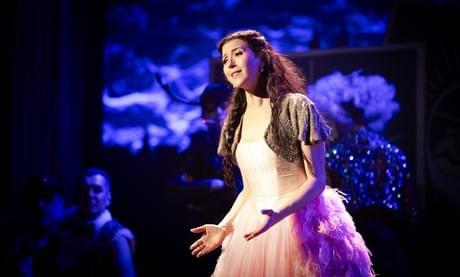
Forum Opera - Interview
Lisette is interviewed by Forum Opera about her upcoming roles
Reviews
Night at the Museum
It’s hard to imagine a more appropriate choice for the role of Cleopatra than the incandescent Lisette Oropesa. A coquette par excellence, she has the vocal and dramatic prowess to embody Ptolemaic Egypt’s last queen. Her glorious lyric coloratura had just the right timbre, feminine and fruity. Vocally, she excelled in all her arias, but her Act II aria “V’adoro pupille” was the most sensual. Technically, her Act III aria “Da tempeste il legno infranto” was the most dazzling.None— Ossama el Naggar • Concerto Net
Lisette Oropesa en Cléopâtre de collection dans Giulio Cesare à Garnier
Cette dernière est incarnée pour cette série de représentations par Lisette Oropesa, qui triomphe de la soirée avec agilité, dans tous les sens du terme. Cléopâtre arrive juchée sur la statue de Ramsès II, la parcourant, minaudant et narguant son frère de là-haut, triomphant de sa féminité sur lui. La voix, au timbre très reconnaissable, semble toujours cacher un sourire. Les aigus sont frais, déjà audibles dans les harmoniques du médium et les ornementations, filées, se dirigent vers les points les plus hautes de sa tessiture, à l’image du personnage espiègle qu’en fait cette mise en scène.In this series of performances, the role is embodied by Lisette Oropesa, who triumphs through the evening with agility, in every sense of the word. Cleopatra arrives perched on the statue of Ramses II, traversing it, coquettishly teasing and taunting her brother from above, triumphing in her femininity over him. The voice, with its very distinctive timbre, seems to always hide a smile. The highs are fresh, already audible in the harmonics of the middle range, and the ornamentations, smoothly executed, reach towards the highest points of her range, reflecting the mischievous character portrayed in this staging.— Jeanne Auffret • Olyrix
Une Nuit au musée Garnier avec Jules César et Cléopâtre
Il est ici confié à Lisette Oropesa qui assume le tour de force de ce rôle aux 8 airs et au sublime duo final avec César. 8 airs et comme l’acmé d’une danse des 7 voiles dans son costume en semi-nudité feinte, mais d’une sensualité assumée, féline et incandescente. Sa voix finement tissée comme de la soie est de même : rayonnante dans les aigus, riche dans le médium et toujours sonore, même dans les tons graves.It is entrusted here to Lisette Oropesa who takes on the tour de force of this role with 8 arias and the sublime final duo with Cesar. 8 arias, like the climax of a dance of the 7 veils in her semi-nude costume, feigned but with a confessed sensuality; feline and incandescent. Her voice, finely woven like silk, is the same: radiant in the high notes, rich in the middle, and always resonant, even in the low tones.— Henry Runey • Classy Keo
« Giulio Cesare » de Haendel : une œuvre magnifique mais une Première inégale
La si belle LisetteCléopâtre c’était la très belle Lisette Oropesa, à la plastique irréprochable qui rend si crédible l’amour que lui porte Jules César dès le premier regard alors qu’il ignore encore qui elle est. Actrice-née, Lisette Oropesa a immédiatement les faveurs du public qui ovationne littéralement chacune de ses ariasThe oh so beautiful Lisette Cleopatra was the very beautiful Lisette Oropesa, with impeccable physical appearance that makes the love that Julius Caesar feels for her so believable from the first glance, even though he still doesn't know who she really is. A born actress, Lisette Oropesa immediately won over the audience, who literally cheered for each of her arias.— Helene Adam • Cult.news
« Giulio Cesare » au Palais Garnier : tous fous de Cléopâtre !
Libérée, épanouie, heureuse, telle apparaît en revanche Lisette Oropesa dès son entrée en scène, tenue légère et pas sautillant. Caractère badin traité sur le mode souriant, voire comique, au premier acte, Cléopâtre gagne en densité mélancolique, tragique même, lorsque son frère Ptolémée abat sa vindicte sur elle. La soprano américaine fait cadeau de son timbre fruité, ensoleillé, sensuel sans l’ombre d’une vulgarité, aux airs insouciants ou triomphants comme aux lamenti poignants : « Si tu n’as pas pitié de moi, ô juste ciel, je vais mourir »…Liberated, fulfilled, happy, this is how Lisette Oropesa appears from her first entrance on stage, dressed lightly and hopping along. Playing a playful character with a smiling, even comical manner in the first act, Cleopatra gains in melancholic density, even tragedy, when her brother Ptolemy unleashes his vengeance on her. The American soprano offers her fruity, sun-kissed, sensual without being vulgar timbre, to carefree or triumphant airs as well as to poignant laments: "If you have no pity for me, oh just heavens, I am going to die"...— Emmanuelle Giuliani • La Croix
Radieuse Cleopatra à l’Opéra de Paris
A l’exemple de Lisette Oropesa qui, après avoir triomphé sur les scènes internationales -Traviata, Gilda, Lucia di Lammermoor, récemment Ophélie, comme dans les premier rôles de Mozart, Rossini, Bellini, Donizetti, propose ici une radieuse incarnation de Cleopatra. Ballerine, gymnaste, elle se joue des chausse-trappes scéniques prêtant sa vivacité, sa grâce et son chic à la séductrice égyptienne, allant jusqu’à s’approprier des mimiques de meneuse de revue -on pense à Mistinguett- conçues à l’origine pour Natalie Dessaye. Du premier au dernier instant, elle déploie sans faiblir un chant lumineux, sain, fruité à souhait. Elle sait également susciter l’émotion lorsque, souveraine déchue, elle se révèle dans sa vérité de femme et sa dignité. Il est permis de chérir les Cléopâtres valétudinaires qui compensent la ténuité par l’agilité mais, également, d’admirer chez cette grande rossinienne la plénitude d’un chant qui, jusque dans des ornements, se met uniquement au service de l’expression.Following the example of Lisette Oropesa, who has triumphed on international stages - in operas such as "Traviata," "Gilda," "Lucia di Lammermoor," and recently as Ophelia, as well as in leading roles by Mozart, Rossini, Bellini, Donizetti, she now offers a radiant portrayal of Cleopatra. A ballet dancer and gymnast, she navigates the pitfalls of the stage, lending her vivacity, grace, and elegance to the Egyptian seductress. She even adopts the mannerisms of a cabaret leader—reminding one of Mistinguett—originally designed for Natalie Dessaye. From the first moment to the last, she consistently projects a bright, healthy, and desirably fruity voice. She also knows how to evoke emotion when, as a fallen sovereign, she reveals her truth as a woman and her dignity. It is permissible to cherish the ailing Cleopatras who compensate for their frailty with agility, but also to admire in this great Rossinian singer the fullness of a song that, even in its ornamentation, serves solely the purpose of expression.— Bénédicte Palaux-Simonnet • Crescendo Magazine
CÉSAR SUPPLANTÉ PAR CLÉOPÂTRE
Pour ce qui concerne la distribution vocale, la divine surprise vient de la soprano Lisette Oropesa, qui incarne une Cléopâtre doublement séductrice par son physique et sa voix aussi souple que puissante,Regarding the vocal casting, the divine surprise comes from the soprano Lisette Oropesa, who embodies a doubly seductive Cleopatra through both her appearance and her voice, which is as flexible as it is powerful.— Noël Tinazzi • Web Theatre
RITIQUE, opéra. PARIS, Palais Garnier, le 20 janvier 2024.
La prestation de la soprano Lisette Oropesa dans le rôle de Cléopâtre est tout aussi surprenante, surtout que nous ne sommes pas habitués à l’entendre dans ce répertoire. Elle est tout à fait piquante et séductrice théâtralement, et possède une maîtrise totale de son instrument. Elle est ravissante et bouleversante dans « V’adoro, pupille » et « Se pietà di me non senti » respectivement, dans l’acte 2, puis virtuose et légère dans son air final à l’acte 3 « Da tempesta il legno infranto ».The performance of the soprano Lisette Oropesa in the role of Cleopatra is equally surprising, especially as we are not used to hearing her in this repertoire. She is quite spicy and theatrically seductive, and has complete control over her instrument. She is delightful and moving in "V'adoro, pupille" and "Se pietà di me non senti" respectively, in Act 2, and then virtuosic and light in her final aria in Act 3, "Da tempesta il legno infranto".— Sabino Pena Arcia • Classique News
Handel nel museo
In questa versione, Cleopatra è il fulcro dell'azione e in questo senso il soprano Lisette Oropesa non ha deluso in nessun momento. Perfetta dal punto di vista attoriale, piena di simpatia e di partecipazione, ha affrontato tutte le insidie della partitura, sia nei momenti di lirismo sia in quelli di forza e agilità. Una grande serata di trionfo per il soprano di New Orleans di origine cubana.In this version, Cleopatra is the focal point of the action, and in this regard, soprano Lisette Oropesa did not disappoint at any moment. Flawless from an acting standpoint, full of charm and engagement, she tackled all the challenges of the score, both in moments of lyricism and in those requiring strength and agility. A great night of triumph for the New Orleans-based soprano of Cuban origin.— Gustavo Gabriel Otero • L'ape musicale
Parigi - Palais Garnier: Giulio Cesare
Lisette Oropesa appare nella piena maturità vocale e si fa luce sin dalle prime arie, per poi imporsi nel corso del secondo atto con un'intensa esecuzione di “Se pietà di me non senti” e soprattutto nel terzo con una pirotecnica “Da tempeste il legno infranto”.Lisette Oropesa appears in full vocal maturity and shines from the very first arias, then asserts herself during the second act with an intense performance of "Se pietà di me non senti", and especially during the third with a pyrotechnic "Da tempeste il legno infranto".— Fabrizio Moschini • Opera Click
Faste retour d’Egypte au Palais Garnier
En Cléopâtre, à peine vêtue d’une tunique blanche presque transparente, la fabuleuse soprano cubano-américaine Lisette Oropesa impose quant à elle une agilité, une précision souveraine dans les trilles acrobatiques de la partition.In Cleopatra, barely dressed in an almost transparent white tunic, the fabulous Cuban-American soprano Lisette Oropesa exhibits an agility, and a sovereign precision in the acrobatic trills of the score.— Julien San Frax • Causeur
Giulio Cesare in Paris
Handel’s world was vibrantly alive with excellent performances by Lisette Oropesa’s Cleopatra and Gaële Arquez’s Giulio Cesare. Louisiana (USA) born Mlle. Oropesa is quite shapely, easily embodying the arrogant and calculating sirene of myth. As Handel’s heroine she is also a sincere lover, ready to die as her brother’s prisoner. As defeated as she was in her heartbreaking “Piangero la sorte mia,” we were smitten by its sincerity. An estimable technician of beautiful voice she wove the florid lines of her multiple arias into a convincing whole.None— Michael Milenski • Opera Today


